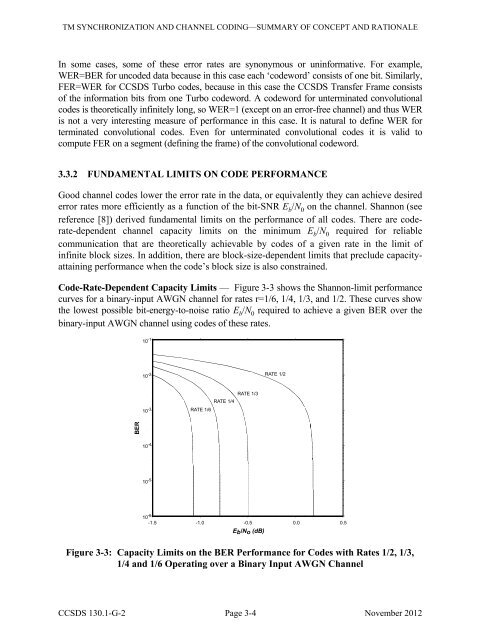130x1g2 - CCSDS
130x1g2 - CCSDS
130x1g2 - CCSDS
Create successful ePaper yourself
Turn your PDF publications into a flip-book with our unique Google optimized e-Paper software.
TM SYNCHRONIZATION AND CHANNEL CODING—SUMMARY OF CONCEPT AND RATIONALEIn some cases, some of these error rates are synonymous or uninformative. For example,WER=BER for uncoded data because in this case each ‘codeword’ consists of one bit. Similarly,FER=WER for <strong>CCSDS</strong> Turbo codes, because in this case the <strong>CCSDS</strong> Transfer Frame consistsof the information bits from one Turbo codeword. A codeword for unterminated convolutionalcodes is theoretically infinitely long, so WER=1 (except on an error-free channel) and thus WERis not a very interesting measure of performance in this case. It is natural to define WER forterminated convolutional codes. Even for unterminated convolutional codes it is valid tocompute FER on a segment (defining the frame) of the convolutional codeword.3.3.2 FUNDAMENTAL LIMITS ON CODE PERFORMANCEGood channel codes lower the error rate in the data, or equivalently they can achieve desirederror rates more efficiently as a function of the bit-SNR E b /N 0 on the channel. Shannon (seereference [8]) derived fundamental limits on the performance of all codes. There are coderate-dependentchannel capacity limits on the minimum E b /N 0 required for reliablecommunication that are theoretically achievable by codes of a given rate in the limit ofinfinite block sizes. In addition, there are block-size-dependent limits that preclude capacityattainingperformance when the code’s block size is also constrained.Code-Rate-Dependent Capacity Limits — Figure 3-3 shows the Shannon-limit performancecurves for a binary-input AWGN channel for rates r=1/6, 1/4, 1/3, and 1/2. These curves showthe lowest possible bit-energy-to-noise ratio E b /N 0 required to achieve a given BER over thebinary-input AWGN channel using codes of these rates.10 -110 -2RATE 1/210 -3RATE 1/3RATE 1/4RATE 1/6BER10 -410 -510 -6-1.5-1.0-0.5Eb/No (dB)0.00.5Figure 3-3: Capacity Limits on the BER Performance for Codes with Rates 1/2, 1/3,1/4 and 1/6 Operating over a Binary Input AWGN Channel<strong>CCSDS</strong> 130.1-G-2 Page 3-4 November 2012

















